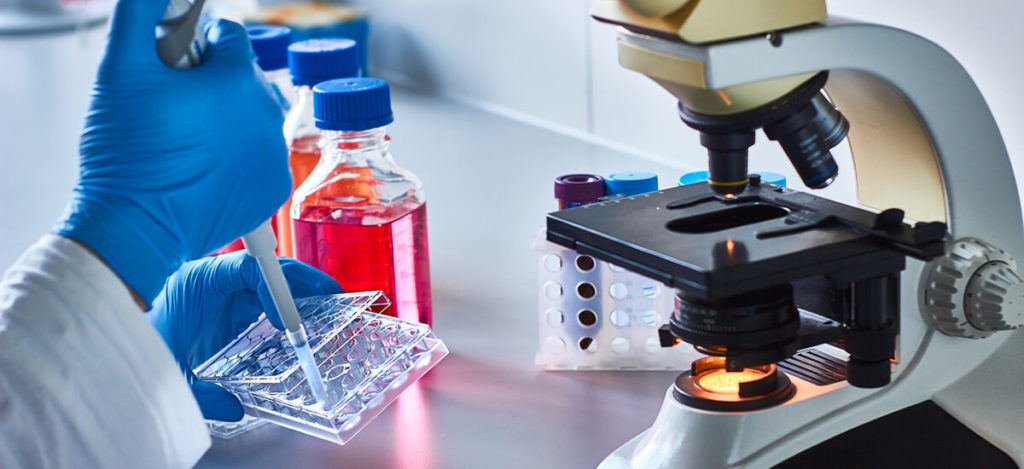RATIONALE: Vaccines made from a person’s cancer cells may make the body build an immune response to and kill their tumor cells. Combining vaccine therapy with interferon gamma may be a more effective treatment for epithelial ovarian cancer.
RATIONALE: Vaccines made from a person’s cancer cells may make the body build an immune response to and kill their tumor cells. Combining vaccine therapy with interferon gamma may be a more effective treatment for epithelial ovarian cancer. PURPOSE: Phase I trial to study the effectiveness of a tumor cell vaccine and interferon gamma in patients with refractory epithelial ovarian cancer. Condition: – recurrent ovarian epithelial cancer Study Type: InterventionalStudy Design: Treatment Official Title: Phase I Pilot Study of Intraperitoneal Autologous Therapeutic Tumor Vaccine AUT-OV-ALVAC-hB7.1 and Interferon Gamma in Patients With Refractory Ovarian Epithelial Cancer Further Study Details: OBJECTIVES:Determine whether intraperitoneal (IP) injections of epithelial ovarian carcinoma cells infected with ALVAC-hB7.1 and IP interferon gamma have acceptable toxicity and produce any clinical responses in patients with refractory ovarian epithelial cancer. OUTLINE: This is a dose-escalation study of ALVAC-hB7.1 infected tumor cells.Patients receive ALVAC-hB7.1 infected tumor cells intraperitoneally (IP) on days 4, 11, and 18. Patients also receive interferon gamma IP on days 8, 10, 15, and 17. In the absence of disease progression, up to 6 courses of therapy may be given. If insufficient tumor cells are available to continue treatment with tumor cell derived vaccine, interferon gamma may be given alone. Cohorts of 3 to 6 patients receive escalating doses of ALVAC-hB7.1 infected tumor cells until the maximum tolerated dose (MTD) is determined. The MTD is defined as the dose at which no more than 2 of 6 patients experience dose-limiting toxicity. Patients are followed every 6 months until disease progression.PROJECTED ACCRUAL: A total of 12 patients will be accrued for this study. Eligibility Genders Eligible for Study: Both Criteria DISEASE CHARACTERISTICS:Diagnosis of ovarian epithelial carcinoma Previously treated with an adequate course of platinum based chemotherapy Evidence of intraabdominal disease No significant adhesions PATIENT CHARACTERISTICS: Age:Any age Performance status:Zubrod 0-2 Life expectancy:Not specified Hematopoietic:Lymphocyte count at least 500/mm^3 Hepatic:Bilirubin no greater than 1.5 mg/dL SGOT less than 2.5 times upper limit of normal Renal:Creatinine no greater than 1.5 mg/dL Cardiovascular:No major disorder of the cardiovascular system Pulmonary:No major disorder of the pulmonary system Other:Not pregnant or nursing Fertile patients must use effective contraception Successful placement of peritoneal catheter No overt autoimmune disease PRIOR CONCURRENT THERAPY: Biologic therapy:Not specified Chemotherapy:See Disease Characteristics Endocrine therapy:No concurrent chronic steroid therapy Radiotherapy:No prior radiotherapy Surgery:Prior surgery allowed Other:Recovered from prior therapy[1] Ralph S. Freedman, MD, PhD, Study Chair, M.D. Anderson Cancer Center
All content and media on the HealthEngine Blog is created and published online for informational purposes only. It is not intended to be a substitute for professional medical advice and should not be relied on as health or personal advice. Always seek the guidance of your doctor or other qualified health professional with any questions you may have regarding your health or a medical condition. Never disregard the advice of a medical professional, or delay in seeking it because of something you have read on this Website. If you think you may have a medical emergency, call your doctor, go to the nearest hospital emergency department, or call the emergency services immediately.







